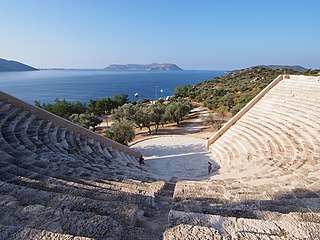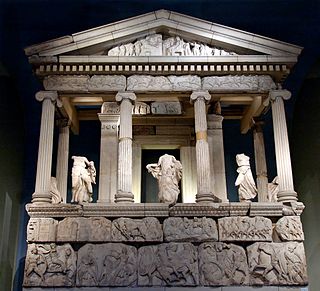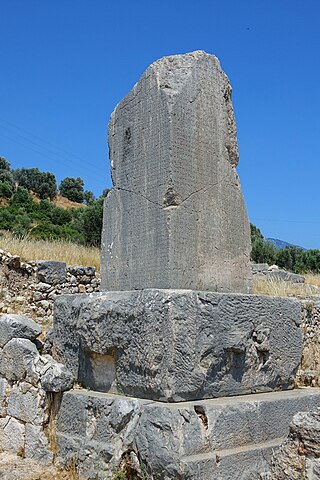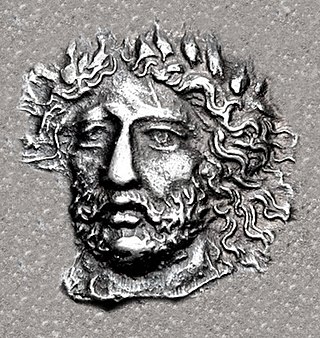Related Research Articles

Lycia was a historical region in Anatolia from 15–14th centuries BC to 546 BC. It bordered the Mediterranean Sea in what is today the provinces of Antalya and Muğla in Turkey as well some inland parts of Burdur Province. The region was known to history from the Late Bronze Age records of ancient Egypt and the Hittite Empire.

Xanthos or Xanthus, also referred to by scholars as Arna, its Lycian name, was an ancient city near the present-day village of Kınık, in Antalya Province, Turkey. The ruins are located on a hill on the left bank of the River Xanthos. The number and quality of the surviving tombs at Xanthos are a notable feature of the site, which, together with nearby Letoon, was declared to be a UNESCO World Heritage Site in 1988.

Sir Charles Fellows was a British archaeologist and explorer, known for his numerous expeditions in what is present-day Turkey.

Autophradates was a Persian Satrap of Lydia, who also distinguished himself as a general in the reign of Artaxerxes III and Darius III.

Pixodarus or Pixodaros, was a satrap of Caria, nominally the Achaemenid Empire Satrap, who enjoyed the status of king or dynast by virtue of the powerful position his predecessors of the House of Hecatomnus created when they succeeded the assassinated Persian Satrap Tissaphernes in the Carian satrapy. Lycia was also ruled by the Carian dynasts since the time of Mausolus, and the name of Pixodarus as ruler appears in the Xanthos trilingual inscription in Lycia.
Kandyba or Candyba was a settlement in ancient Lycia, in modern-day Antalya province on the southwestern Mediterranean coast of Turkey.

Cadyanda or Kadyanda was a town of ancient Lycia. The site was discovered by Charles Fellows. The decree of Pixodarus now in the British Museum shows that the Lycian name of the town was Xadawãti.

Antiphellus or Antiphellos, known originally as Habesos, was an ancient coastal city in Lycia. The earliest occurrence of its Greek name is on a 4th-century-BCE inscription. Initially settled by the Lycians, the city was occupied by the Persians during the 6th century BCE. It rose in importance under the Greeks, when it served as the port of the nearby inland city of Phellus, but once Phellus started to decline in importance, Antiphellus became the region's largest city, with the ability to mint its own coins. During the Roman period, Antiphellus received funds from the civic benefactor Opramoas of Rhodiapolis that may have been used to help rebuild the city following the earthquake that devastated the region in 141.

The Nereid Monument is a sculptured tomb from Xanthos in Lycia, close to present-day Fethiye in Mugla Province, Turkey. It took the form of a Greek temple on top of a base decorated with sculpted friezes, and is thought to have been built in the early fourth century BC as a tomb for Arbinas, the Xanthian dynast who ruled western Lycia under the Achaemenid Empire.

The Tomb of Payava is a Lycian tall rectangular free-standing barrel-vaulted stone sarcophagus, and one of the most famous tombs of Xanthos. It was built in the Achaemenid Persian Empire, for Payava, who was probably the ruler of Xanthos, Lycia at the time, in around 360 BC. The tomb was discovered in 1838 and brought to England in 1844 by the explorer Sir Charles Fellows. He described it as a 'Gothic-formed Horse Tomb'. According to Melanie Michailidis, though bearing a "Greek appearance", the Tomb of Payava, the Harpy Tomb and the Nereid Monument were built according to the main Zoroastrian criteria "by being composed of thick stone, raised on plinths off the ground, and having single windowless chambers".

The Harpy Tomb is a marble chamber from a pillar tomb that stands in the abandoned city of Xanthos, capital of ancient Lycia, a region of southwestern Anatolia in what is now Turkey. Built in the Persian Achaemenid Empire, and dating to approximately 480–470 BC, the chamber topped a tall pillar and was decorated with marble panels carved in bas-relief. The tomb was built for an Iranian prince or governor of Xanthus, perhaps Kybernis.

The Xanthian Obelisk, also known as the Xanthos or Xanthus Stele, the Xanthos or Xanthus Bilingual, the Inscribed Pillar of Xanthos or Xanthus, the Harpagus Stele, the Pillar of Kherei and the Columna Xanthiaca, is a stele bearing an inscription currently believed to be trilingual, found on the acropolis of the ancient Lycian city of Xanthos, or Xanthus, near the modern town of Kınık in southern Turkey. It was created when Lycia was part of the Persian Achaemenid Empire, and dates in all likelihood to c. 400 BC. The pillar is seemingly a funerary marker of a dynastic satrap of Achaemenid Lycia. The dynast in question is mentioned on the stele, but his name had been mostly defaced in the several places where he is mentioned: he could be Kherei (Xerei) or more probably his predecessor Kheriga.

Mithrapāta was dynast of Lycia in the early 4th century BC, at a time when this part of Anatolia was subject to the Persian, or Achaemenid, Empire.

Cyaneae, also spelled Kyaneai or Cyanae, was a town of ancient Lycia, or perhaps three towns known collectively by the name. Leake observes that in some copies of Pliny it is written Cyane; in Hierocles and the Notitiae Episcopatuum it is Cyaneae.
Dias was a city of ancient Lycia mentioned by Stephanus of Byzantium. It has been suggested, with some uncertainty, that a coin minted at Dias is in the collection of the British Museum.
Acalissus or Akalissos was a town of ancient Lycia, an early bishopric, and remains a titular see of the Roman Catholic Church. Coins were minted at Acalissus, some of which are housed at numismatic collections.

Xanthos, also called Xanthus, was a chief city state of the Lycians, an indigenous people of southwestern Anatolia. Many of the tombs at Xanthos are pillar tombs, formed of a stone burial chamber on top of a large stone pillar. The body would be placed in the top of the stone structure, elevating it above the landscape. The tombs are for men who ruled in a Lycian dynasty from the mid-6th century to the mid-4th century BCE and help to show the continuity of their power in the region. Not only do the tombs serve as a form of monumentalization to preserve the memory of the rulers, but they also reveal the adoption of Greek style of decoration.

Arbinas, also Erbinas, Erbbina, was a Lycian Dynast who ruled circa 430/20-400 BCE. He is most famous for his tomb, the Nereid Monument, now on display in the British Museum. Coinage seems to indicate that he ruled in the western part of Lycia, around Telmessos, while his tomb was established in Xanthos. He was a subject of the Achaemenid Empire.

Kybernis or Kubernis, also abbreviated KUB on his coins in Lycian, called Cyberniscus son of Sicas by Herodotus, was a dynast of Lycia, at the beginning of the time it was under the domination of the Achaemenid Empire. He is best known through his tomb, the Harpy Tomb, the decorative remains of which are now in the British Museum. According to Melanie Michailidis, though bearing a "Greek appearance", the Harpy Tomb, the Nereid Monument and the Tomb of Payava were built according main Zoroastrian criteria "by being composed of thick stone, raised on plinths off the ground, and having single windowless chambers".

Perikles, was the last known independent dynast of Lycia. A dynast of Limyra in eastern Lycia c. 375–362 BCE, he eventually ruled the entire country during the Revolt of the Satraps, in defiance of the Achaemenid Empire.
References
- ↑ Plin. v. 28.
- ↑ Trevor Bryce, Jan Zahle (1986). The Lycians: The Lycians in literary and epigraphic sources. Museum Tusculanum Press. p. 229. ISBN 978-87-7289-023-4 . Retrieved December 10, 2014.
- ↑ Sir George Francis Hill (1897). Catalogue of the Greek Coins of Lycia, Pamphylia, and Pisidia. A Catalogue of the Greek Coins in the British Museum. The Trustees. p. lvii. Retrieved December 10, 2014.
- ↑ Thomas Abel B. Spratt, Edward Forbes (1847). Travels in Lycia, Milyas, and the Cibyratis. pp. 282-283. Retrieved December 10, 2014.